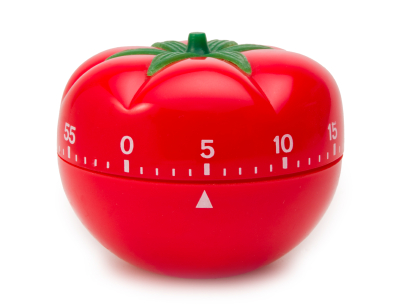How to Conquer the World (25 Minutes at a Time) Part 1
 Monday, February 21, 2011 at 08:54PM
Monday, February 21, 2011 at 08:54PM 
From 1980 to 1990, I was a pretty serious runner.
10K’s (6.2 miles) were my main gig.
I threw in a few 5K’s and 10 milers to spice things up a bit.
Training for these races often involved running “intervals”
Intervals means you to run a series of short, focused sprints.
Short, focused sprints pushes your oxygen consumption to its max.
The end result? You run faster and further, improving your racing times.
Imagine applying highly focused “sprints” to your projects
So your output (and creativity) improves significantly.
That’d be pretty cool, huh?
Guess what? I came across a time management technique that uses the same principle.
My productivity (and creativity) boosted quite a bit using this super-simple method so I figured hey, why not share it with you, too?
It’s called the Pomodoro Technique. (And it’s free.)
What is the Pomodoro Technique?
The Pomodoro Technique is a time management tool. I know, I know. How boring is that, right?
You’re thinking this is another gimmick. How many more of these things do we need to know about?
Hang on. That’s what I thought, too. Man, was I ever wrong.
I’m probably like you. I have my to-do list ready to go every day. Sometimes I’m successful. Sometimes I’m not.
The problem with time? It’s invisible
It’s hard to see, feel, touch or grasp. But grasp it we must if we’re committed to accomplishing (and conquering) the things we want to do today, tomorrow or in five years.
In the late 1980’s, Francesco Cirillo was a student. As a student he was frustrated he couldn’t concentrate on his homework like he wanted to. Too many distractions were getting in his way.
Francesco made a bet with himself
Could he concentrate (without being distracted) for just 10 minutes? Hmm. If he could, how would he know when the 10 minutes was up? He needed to validate his time. He needed a timer. Then he spotted a kitchen timer in the shape of a pomodoro.

A pomodoro? What’s that?
“Pomodoro” means “tomato” in Italian. The kitchen timer Francesco used to time his work was in the shape of a tomato. The timer enabled him to measure how much time he could concentrate on his homework. Over time, Francesco settled on 25 minutes as an optimum time to focus his efforts on a project before needing a short break.
The Pomodoro Technique was born
Time could be captured and put in a “box.”
25-minute boxes.
So why bother using the Pomodoro Technique?
When we focus intensely on only one task for 25 minutes, we immediately feel a sense of accomplishment. In addition:
• You strengthen your resolve to continue applying yourself.
• Your anxiety to accomplish difficult projects is lessened.
• Your motivation to do more increases.
• Your concentration deepens with fewer interruptions.
All this changes how we see time.
Time isn’t your enemy anymore. Time becomes your friend
Gone are the days of thinking, “I’m not getting out my chair for the next three hours till this is done!”
Spend three hours on a project if you want
But try “sprinting” your way through those three hours.
Take short breaks in-between the 25-minute sessions.
You’ll feel a difference.
In Part 2, we’ll look at:
• What you need to start.
• How to start.
• How to handle interruptions.
• Where to get some neat (and free) tools to help you get the most out of the method.
P.S. I’m not running anymore. Um, biking is easier on the knees!



Reader Comments (1)